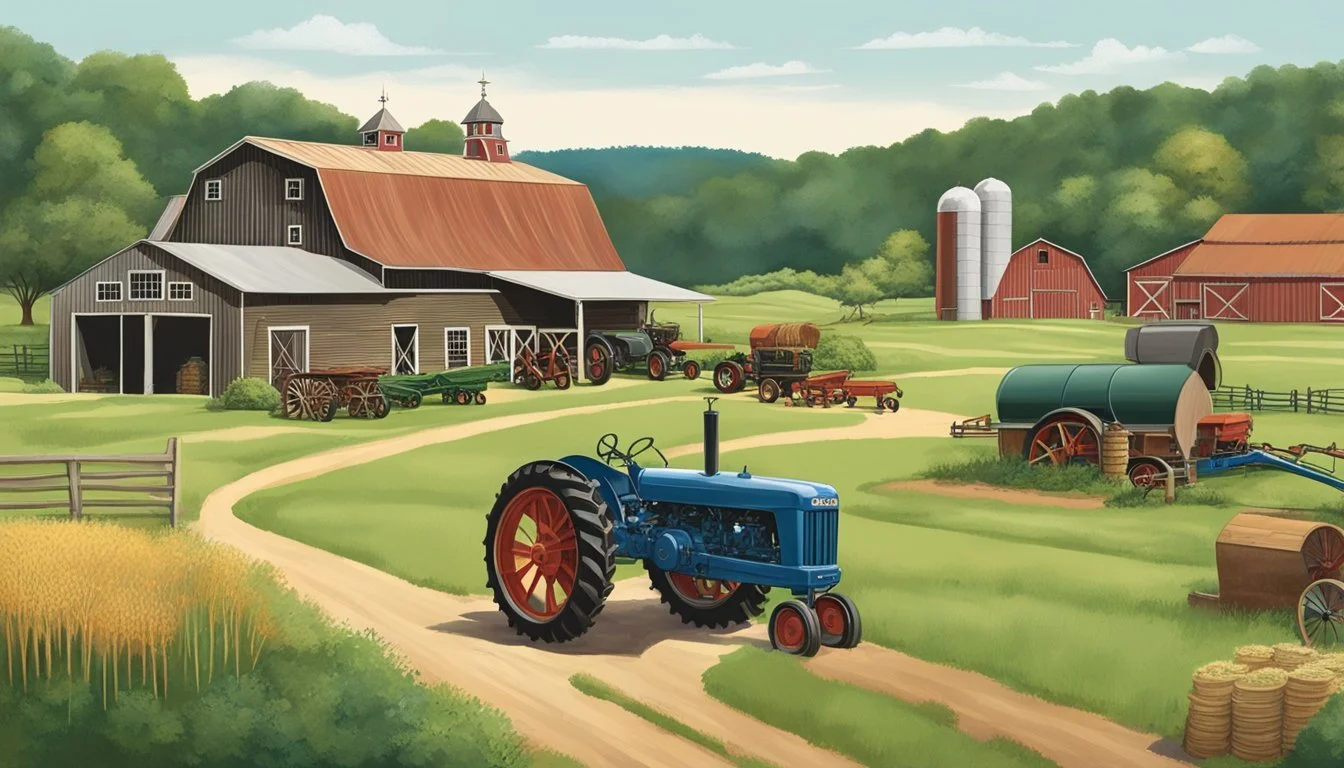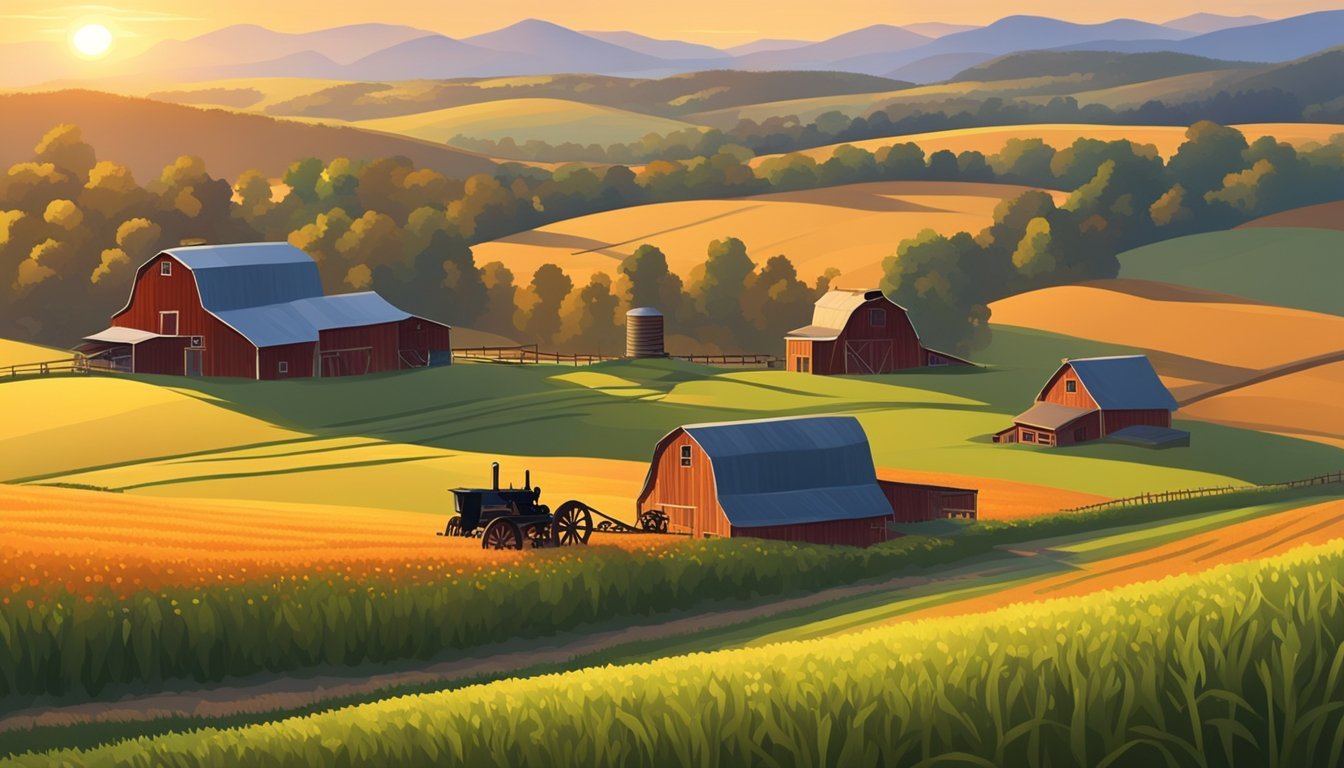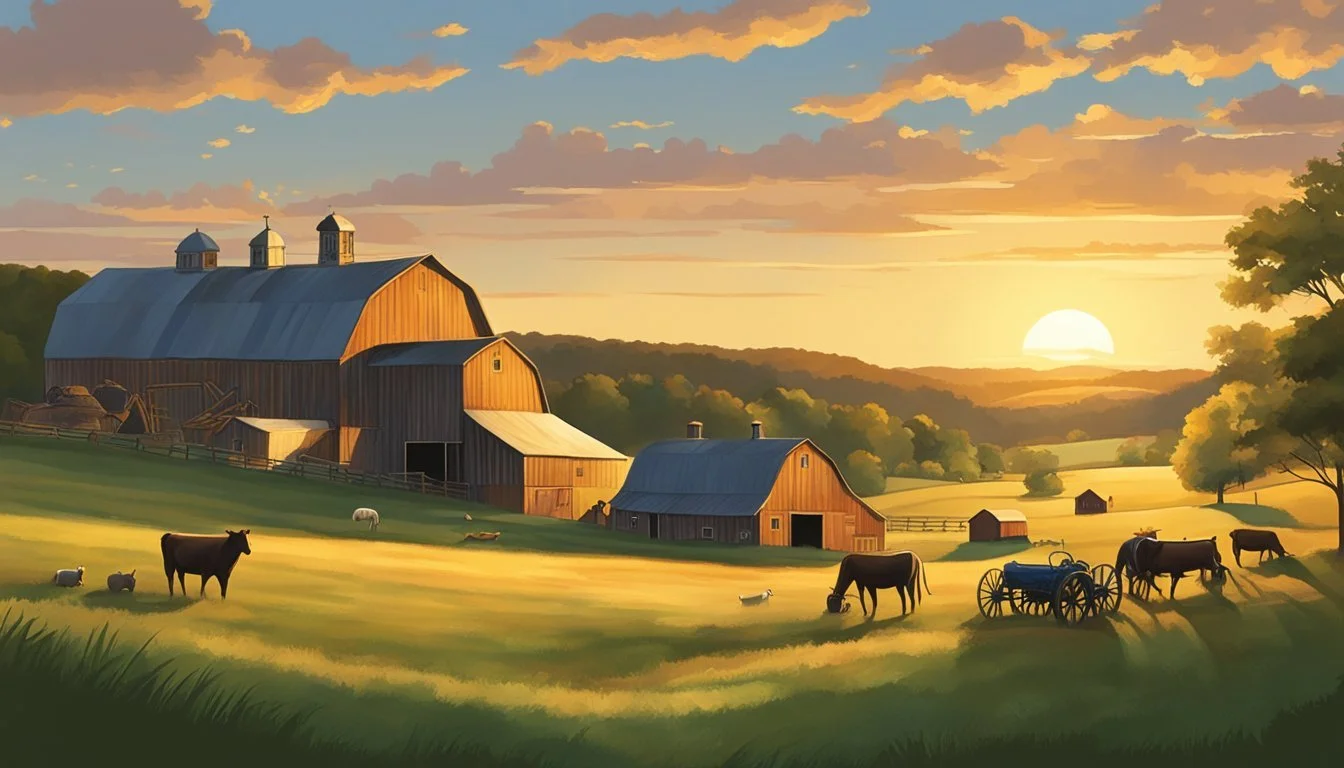Historical Farms and Agricultural Museums in Connecticut
A Guide to Preserved Heritage Sites
Connecticut's rich history is deeply rooted in agriculture, a testament to its enduring legacy visible through the numerous historical farms and specialized agricultural museums across the state. These institutions serve not only as guardians of the past but also as educational resources, offering insights into the evolving relationship between the people of Connecticut and the land they have cultivated for centuries. Through careful preservation and presentation, they allow visitors to step back in time and experience first-hand the significance of farming to the region's development.
The landscapes, buildings, and artifacts found in places like the Dudley Farm Museum in Guilford provide authentic representations of 19th-century farm life, complete with barns, gardens, and livestock. Exhibits and demonstrations highlight the ingenuity and skills farmers employed to sustain their communities and the state's economy. Beyond the illustration of historical practices, these sites often address the social and historical context of agriculture, revealing Connecticut's transformation from a colonial settlement to a contributor to the nation's agricultural prowess.
Additionally, unique locales such as the Connecticut Antique Machinery Association Museum offer a specialized focus on the mechanical evolution in farming, showcasing the advancement from simple tools to complex machinery. They honor the state's role in the industrialization of agriculture, further enriching visitors' understanding of how technological changes shaped the farming landscape and the daily lives of Connecticut's people.
Historical Overview Of Connecticut Farming
Connecticut's agricultural landscape reflects a rich history that evolved from early subsistence farming to specialized industries such as dairy and tobacco farming, integral to its economic development.
Early Settlement and Farm Practices
Upon their arrival, European settlers in Connecticut began transforming the land into viable farmland. By the early 19th century, approximately 90% of residents were engaged in agriculture to sustain their livelihoods, with even professionals like lawyers and physicians cultivating crops to feed their families. The state's small-scale farms focused on a variety of crops, offering a rich tapestry of local food production.
Development Of The Dairy Industry
The dairy industry experienced significant growth during Connecticut's agricultural development. Small farms initially contributed to local economies with dairy production. The state's dairy farms became a staple in Connecticut’s agricultural identity, reflecting a nationwide trend towards specialization and commercialization in farming. These farms supplied residents with essential dairy products and gradually shaped the rural landscape.
Tobacco Farming and Industrial Growth
Connecticut's tobacco industry surged in the 19th and 20th centuries, particularly known for its high-quality wrapper leaves used in cigar manufacturing. The state's tobacco farms, prominent in the Connecticut River Valley, bolstered the economic transition from a purely agricultural society to one embracing industrial growth. Technological advancements in agriculture helped maintain the productivity of these tobacco farms despite decreasing farmland acreage well into the 21st century.
Agricultural Museums And Living History Farms
Connecticut offers a rich tapestry of agricultural history, illustrated through its numerous living history farms and agricultural museums. These sites provide an immersive experience into the past's farming traditions, offering a tangible link between modern-day agriculture and its historical roots.
Overview of Agricultural Museums
Agricultural museums in Connecticut serve as repositories of the state's rich farming heritage. They safeguard artifacts, implements, and documents that paint a vivid picture of the agricultural past. Among these, historic barns stand as a testament to the craftsmanship and architectural ingenuity that went into creating structures that were both functional and aesthetically pleasing. These museums often feature permanent and rotating exhibits that explore the evolution of farming techniques, the role of agriculture in the state's economic development, and the transitions from traditional to modern farming practices.
The Significance of Living History Farms
Living history farms bring agricultural history to life through hands-on experiences and interactive demonstrations. These farms operate with a commitment to authenticity, showing visitors how people farmed, lived, and worked in bygone eras. One can expect to encounter everything from dairy cows being milked using historical methods to gardens cultivated with heirloom seeds. These farms often host educational programs and events that facilitate a deep understanding of historical farming life. They are significant not only as centers of education but also as cultural resources preserving agricultural knowledge and skills that could otherwise be lost. The Association for Living History, Farm and Agricultural Museums (ALHFAM), moreover, supports these living history sites through networking and professional development, ensuring that they remain vital parts of historical education.
Famous Connecticut Farms And Restoration Projects
Connecticut's landscape is dotted with historically significant farms, accentuating the state's rich agricultural past. Efforts to preserve these treasures have led to a range of restoration projects seeking to maintain the rural character and heritage of the region.
Notable Farms in Connecticut's History
The history of Connecticut's agriculture is profoundly anchored in its notable farms. Strong Farm, established in 1878 in Vernon, stands as a testament to the state's farming resilience. The farm, currently covering 350 acres, originated from a purchase by John E. Wike and his family, marking the beginning of a longstanding agricultural legacy (Connecticut Explored).
Walnut Ledge Farm in South Glastonbury is another iconic entity, with its roots deeply embedded within Connecticut's agricultural framework. Although the number of active farms has declined, those remaining continue a proud tradition of contributing to the state's economy, from dairy to vegetables (Connecticut History).
Restoration and Preservation Initiatives
The preservation of Connecticut's agricultural history is an ongoing endeavor with initiatives targeting a variety of restoration projects. The Ludorf Farm Museum in Southbury highlights this commitment, with aims to restore the circa 1820 Ludorf Barn to function as a center for agricultural historical studies. In 2011, the Southbury Historical Society received a significant grant from the 1772 Foundation to aid in the barn's restoration efforts (Ludorf Farm Museum).
Preservation Connecticut actively works to maintain historic barns, ensuring they remain a part of the contemporary landscape. These barns, emblematic of the state's farming past, are being rehabilitated through adaptive re-use strategies and conservation efforts—emphasizing their role in the state's heritage (Historic Barns of Connecticut).
Educational Programs And Community Engagement
Connecticut's rich history in agriculture is showcased through vibrant educational programs and active community engagement efforts. Museums and organizations across the state provide a hands-on learning experience that brings the past to life, intertwines with scientific knowledge, and fosters a connection among community members.
Learning Opportunities at Farms and Museums
Educational programs are central to museums' operations, ensuring that visitors can explore the convergence of history, farming practices, and science. The Connecticut River Museum exemplifies this approach by offering programs that meet state curriculum standards across diverse subjects. Trained educators lead students through a variety of activities that emphasize inquiry and discovery, embedding valuable cultural lessons within each experience.
Agricultural museums offer insights into the evolution of farming via exhibits and interactive sessions. These museums engage members in activities that address sustainable practices and the importance of farming to local economies.
Contributions Of Agriculture Organizations
Organizations dedicated to agricultural history, such as Connecticut History's project on agriculture, play a pivotal role in offering resources and educational materials. They aid the community in understanding agriculture's role in shaping Connecticut's identity. By delivering content such as documentaries and curated historical archives, these organizations ensure that the legacy of Connecticut farming continues to influence current and future generations.
Community engagement is further augmented by the efforts of historical societies, including the Connecticut Historical Society. These entities often receive funding to assist in their mission of preserving and educating about the state's agricultural background. Through museum experiences and libraries, they offer a deep dive into the state's rich heritage, as well as supporting arts programs that spotlight the cultural implications of agriculture.
Agricultural and Farming Practices
In Connecticut, agricultural and farming practices continue to be shaped by a rich history, informed by innovative techniques in crop cultivation and livestock management.
Cultivating Crops and Harvest Techniques
Connecticut's farming practices have evolved to emphasize sustainable and efficient cultivation methods. They've adopted crop rotation and soil management strategies to maintain soil fertility, which supports a variety of crops including vegetables like tomatoes, and fruits such as apples. The harvest techniques range from hand-harvesting for delicate fruits to mechanized equipment for grains, ensuring quality and minimizing losses.
Animal Husbandry and Livestock Care
Livestock care in Connecticut reflects a commitment to both tradition and welfare. Farmers provide sheltered housing, schedule regular veterinary check-ups, and adhere to a diet that ensures the health of animals like cows and chickens. This meticulous care results in quality farm products, including eggs and dairy, integral to Connecticut's agriculture. The Association for Living History, Farm and Agricultural Museums showcases historical insights into animal husbandry practices that have shaped modern methods.
Visiting Connecticut's Agricultural Heritage Sites
Connecticut offers a rich tapestry of agricultural history through its numerous farms and museums. These sites provide a scenic backdrop to a state that values its past, presenting unique opportunities for learning and leisure.
Planning Your Visit
To experience Connecticut's farming heritage, it's important to plan ahead. While some attractions may welcome walk-in visitors, many sites suggest or require advance booking. Connecticut’s tourism website, CTvisit, is a reputable source for travel deals and scheduling. Consider the seasonal nature of agricultural activities when planning, as different seasons may offer varying experiences from harvesting to maple sugaring.
Entity Significance in Planning Dudley Farm Museum To immerse in 19th-century farm life, a visit here is a must. Check for any special events. Heckscher Farm A perfect spot for families; confirm the opening hours to enjoy the full range of activities. Glebe House & Garden Make a reservation to explore the historic home and garden marvels.
Unique Features and Attractions
Connecticut's agriculture-related attractions dive into both historic and contemporary farm life. At the Dudley Farm Museum, visitors can step back into the 19th century and see how a New England farm operated. Beyond the Dudley Farm's picturesque setting, travelers might visit the Glebe House & Gertrude Jekyll Garden in Woodbury to appreciate a fusion of historic architecture and designed landscape.
The Heckscher Farm is a 10-acre oasis where children and adults alike can engage with farm animals and learn about modern farm practices. Each site hosts a bevy of attractions, from barn tours to gardening workshops, fostering a deeper connection and understanding of Connecticut’s agricultural roots.
Connecting With Connecticut's Farming Community
In the heart of New England, Connecticut's farming heritage is preserved and celebrated in a variety of ways that offer a tangible connection to the region's agricultural past. Visitors and residents alike can immerse themselves in this rich history by exploring the historic family farms that dot the landscape, each with its own story to tell.
Strong Farm, Vernon: Established in 1878, this farm is a testament to the enduring legacy of farming in Connecticut.
Walnut Ledge Farm, South Glastonbury: Offers a glimpse into the state's farmland preservation efforts.
Himmelstein Homestead Farm, Lebanon: Built around 1821, represents the deep-rooted history of Jewish farmers in the region.
For those seeking a more structured experience, Connecticut's agricultural fairs are a seasonal highlight, showcasing the best of what local farms produce and providing entertainment for all ages. They serve as a vibrant gathering place, reinforcing the sense of community among farmers and visitors.
Stay Informed:
Free Newsletter How to Subscribe CT Grown Agriculture Updates Sign up with your email address online
By subscribing to the newsletter, individuals receive the latest news and related articles directly to their inbox, keeping them informed about agricultural events and developments within the state.
For further engagement, one can reach out directly to the farming community via the farms' listed contact information or participate in educational programs that many farms and museums offer. Exploring these living pieces of Connecticut's agrarian history not only enriches the knowledge of the subject but also supports the preservation of these invaluable assets for generations to come.









